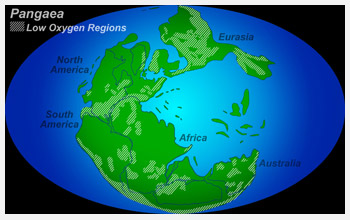Multimedia Gallery
Reduced Oxygen Contributed to "Great Dying" (Image 1)
A depiction of the supercontinent Pangaea some 250 million years ago shows regions where oxygen was insufficient for animal survival. Because oxygen levels decrease with increasing altitude, the more mountainous "hatched" areas would have prevented intermingling and reproduction between nearby animal populations.
As atmospheric oxygen decreased in the late Permian period, hypoxia, or insufficient oxygen in bodily tissue, would have become an undeniable problem for Earth's terrestrial species. National Science Foundation-supported researchers predicted that eventually, because oxygen levels decrease as altitude increases, only land near sea level would have been habitable on the relatively new supercontinent of Pangaea a result of this so-called "altitudinal compression," even modestly high mountai. As ns would have represented insurmountable barriers that prevented intermingling and reproduction between nearby populations.
This image accompanied NSF press release, "Reduced Oxygen Contributed To 'Great Dying.'" [See related image Here.]
Credit: Nicolle Rager Fuller, National Science Foundation
Images and other media in the National Science Foundation Multimedia Gallery are available for use in print and electronic material by NSF employees, members of the media, university staff, teachers and the general public. All media in the gallery are intended for personal, educational and nonprofit/non-commercial use only.
Images credited to the National Science Foundation, a federal agency, are in the public domain. The images were created by employees of the United States Government as part of their official duties or prepared by contractors as "works for hire" for NSF. You may freely use NSF-credited images and, at your discretion, credit NSF with a "Courtesy: National Science Foundation" notation.
Additional information about general usage can be found in Conditions.
Also Available:
Download the high-resolution JPG version of the image. (289 KB)
Use your mouse to right-click (Mac users may need to Ctrl-click) the link above and choose the option that will save the file or target to your computer.



